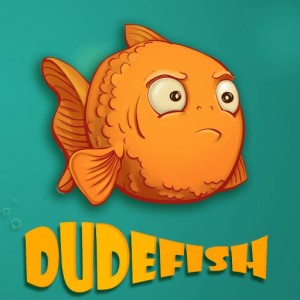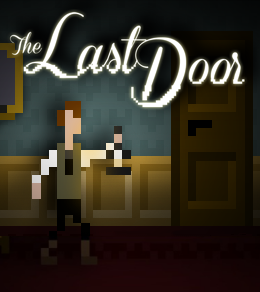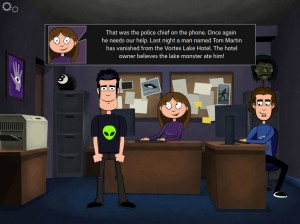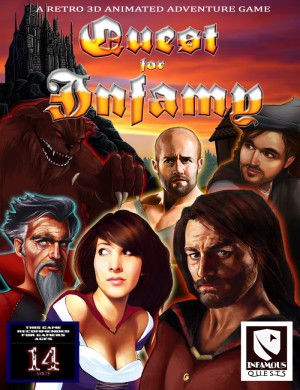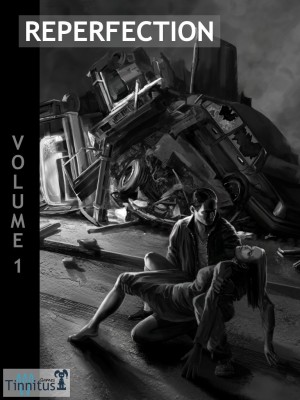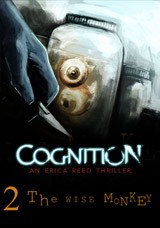Following Freeware: October 2013 releases

This month you can take on the role of a Komodo dragon hunting for food, or a dude that has suddenly found himself turned into a goldfish. Investigators can look into a horrible murder, check out reports of a lake monster eating the tourists, or pursue supernatural beings of a far more disturbing nature. Perhaps you'd like to take a journey into the dark past of a Victorian gentleman or attempt to fix a post-apocalyptic future with the power of melody. Alternatively, you could just hang around inside your head, though you may find the contents more disturbing than normal. All these await you in this month’s round-up of releases from the freeware scene.
Absent
After drawing a picture of a strange and scary creature in her notebook at school, Crystal is 'taken' by a creature that looks a lot like the one she drew, suddenly disappearing from the world and leaving only her mobile phone behind. Three days later, Steve finds her phone and is devastated that his girlfriend has disappeared, so his friend Murray agrees to look for her. Murray soon finds out that what happened is much more complicated than he ever could have imagined. Helped by visions that he never had before, Murray discovers that Crystal was taken by a Reaper. In his quest to get Crystal back, he finds out that he has a decisive role to play in this adventure.
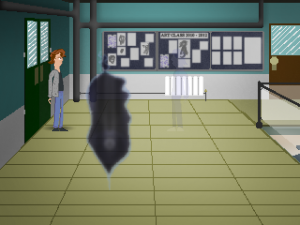 Most of this game by fentonfilmgames takes place in and around the school where Murray and his friends study. The environment is presented in hand-drawn 2D slides in which the characters can walk around. The resolution of the graphics is low; so low in fact that sometimes the text on the screen is hardly readable – the small font used in conversations to choose Murray's lines are especially hard to read. Thankfully, the voice acting is very good. The voices are clear and easy to understand, and they portray the emotions felt by the characters very well. Here and there the game has background music that nicely fits the scene in which it is played.
Most of this game by fentonfilmgames takes place in and around the school where Murray and his friends study. The environment is presented in hand-drawn 2D slides in which the characters can walk around. The resolution of the graphics is low; so low in fact that sometimes the text on the screen is hardly readable – the small font used in conversations to choose Murray's lines are especially hard to read. Thankfully, the voice acting is very good. The voices are clear and easy to understand, and they portray the emotions felt by the characters very well. Here and there the game has background music that nicely fits the scene in which it is played.
You control Murray using the mouse. Right-clicking cycles through the possible actions, like walk, use, look, and talk, and left-clicking performs the desired action. Clicking the inventory icon brings up all the items in your possession; left-clicking selects an object, right-clicking gives a description and sometimes more inventory items. Hotspots are indicated by text labels, and often the cursor changes automatically to represent the 'use' action. This is handy but when you want another action it can be annoying. During conversation, a list of things Murray can say appears at the bottom of the screen. Click on the sentence you think is appropriate and the dialogue continues.
The puzzles are fairly easy but well made and integrated into the story. However, there is a rather large amount of backtracking involved in solving many of them. The characters and story are well thought out. Each person has their own distinct personality that fits their voices perfectly. There are a few long sequences where you just have to watch things unfold, but Absent is a long game with a very complex and twisting plot, and there is a nice side story with some funny and intricate details. The ending is very well done, wrapping the story up nicely and leaving no loose ends. All in all, this game is a remarkable achievement, in many ways outdoing some commercial alternatives.
Absent can be downloaded from the Adventure Game Studio.
Dudefish: Episode 1
I used to be a dude, but now I’m a goldfish. It looks like I’m not the only aquatic sea creature down here that used to be a man either. The grumpy crab, Omar, says that he used to work with a mad scientist named Doctor Lloyd. Using a project they worked on together, the Tranfuze Gunzor, he has been turning hundreds of people into sea creatures of various sorts. But Omar has a plan to get back onto land, retrieve the gun and turn everyone back. All he needs is a brave and skilful fish to bring him the vital part he needs. Until such a fish turns up, I guess I’ll have to do.
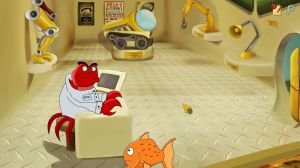 Perfectly Paranormal’s new game series introduces a cowardly fish with a major identity problem. The backgrounds are nicely detailed, with rubbish thrown into the sea by humans having been turned into homes for fish. In some cases, the colour palette is also used to provide atmosphere for a location, such as the black and white graphics of the film noir-style bar. There is also good use of shading to give depth to the various scenes. By contrast, the characters are more simply drawn, usually with a single dominant colour. This is not to say that they are unexpressive, with Dudefish in particular showing a variety of emotions over the course of his adventure. The characters also have individual animations, such as the octopus barman mixing drinks behind his body with his spare tentacles. The game is fully voiced with a variety of accents and characters. There is also soft music playing in the background.
Perfectly Paranormal’s new game series introduces a cowardly fish with a major identity problem. The backgrounds are nicely detailed, with rubbish thrown into the sea by humans having been turned into homes for fish. In some cases, the colour palette is also used to provide atmosphere for a location, such as the black and white graphics of the film noir-style bar. There is also good use of shading to give depth to the various scenes. By contrast, the characters are more simply drawn, usually with a single dominant colour. This is not to say that they are unexpressive, with Dudefish in particular showing a variety of emotions over the course of his adventure. The characters also have individual animations, such as the octopus barman mixing drinks behind his body with his spare tentacles. The game is fully voiced with a variety of accents and characters. There is also soft music playing in the background.
If the idea of playing a man turned into a goldfish wasn’t a clue, this is not a game that takes itself seriously. The protagonist is not a brave hero, but a coward that just hates being a fish. The four-action point-and-click cursor controls allow you to interact with people and objects in a variety of ways. You will meet a very strange pair of eels in the bar toilet and a transsexual seagull up on the dock. An in-game notebook keeps track of major plot points for reference, though it does not record all the information you need for one puzzle. The inventory includes a device that allows you to combine two items, a feature you will use regularly. Overcoming the hero’s cowardice, at least temporarily, and learning the history of the undersea town where the action takes place are also vital. The game also includes some fourth-wall breaking, such as the protagonist knowing he must need an item simply because another character is selling it.
Dudefish: Episode 1 can be downloaded from the developers’ website.
Olav & the Lute
Set in a mystical, post-apocalyptic fantasy world, Olav & the Lute is clearly inspired by one of the most beloved adventure games of all time, Loom. Developed by Johann and Daniel von Appen and Shelly Alon (with sounds by Quirin Nebas), this is a melody-based puzzle game where you play as a character who has acquired a magical lute that is capable of transforming the environment. The more melodies that you learn, the more ways you find to clean up the environment, ultimately working your way towards controlling a giant loom which is able to free you from the ruinous wasteland.
 Olav & The Lute is set in a spoiled version of Japan’s countryside. Certain objects inform you of this early on, including an irradiated barrel ‘made in Fukushima’ and a shishi-odoshi – an object traditionally used in Japan to scare away birds. While the inclusion of such objects situates the game in the land of the rising sun, the aesthetics also use nature as a central theme. The graphics look as if the designers went over the artwork with a set of paint brushes. The result looks very pretty, displaying the world in bright colours and shadows. The environments take you from inside caves to the foot of mountainside regions and next to running rivers as Olav makes his way across a land that has been spoiled by a lot of garbage. This includes visible objects such as broken bicycles, smashed electrical equipment and even nuclear waste. Despite these problems, a calm soundtrack plays constantly in the background, sounding much like a choir harmony.
Olav & The Lute is set in a spoiled version of Japan’s countryside. Certain objects inform you of this early on, including an irradiated barrel ‘made in Fukushima’ and a shishi-odoshi – an object traditionally used in Japan to scare away birds. While the inclusion of such objects situates the game in the land of the rising sun, the aesthetics also use nature as a central theme. The graphics look as if the designers went over the artwork with a set of paint brushes. The result looks very pretty, displaying the world in bright colours and shadows. The environments take you from inside caves to the foot of mountainside regions and next to running rivers as Olav makes his way across a land that has been spoiled by a lot of garbage. This includes visible objects such as broken bicycles, smashed electrical equipment and even nuclear waste. Despite these problems, a calm soundtrack plays constantly in the background, sounding much like a choir harmony.
The purpose of Olav & The Lute is to discover a range of hidden melodies and to re-write the ecological destruction that has ruined the countryside. Each string on your lute represents a note and a color. Each learnable melody consists of four individual musical notes and their accompanying colors. Solving puzzles requires you to first click on the object that you wish to affect before clicking on the lute and then each individual color to create the melody. These become forever etched in a notebook which rests in the bottom-left hand corner of the screen, so playing each one becomes a simple matter of color repetition. When these melodies are played forward they have one effect and when played in reverse they have the opposite effect, opening up two separate spells that can be achieved by each melody, such as opening and closing doors or filling and draining rivers. While you can freely navigate around using the mouse (left-click) to move, you cannot touch anything with your own hands. It is only by virtue of the lute that you can make any progress in this wasteland.
Olav & The Lute can be played online at JayisGames or downloaded from the official website.
The Last Door: Chapter 2 – Memories
Despite rushing urgently to his remote manor house, I arrived too late to save my friend, Jeremiah Devitt. His final message told me that something in our past was coming back to haunt all members of the group we belonged to in our school days. Furthermore, since that tragic day, I have been tormented by horrific dreams which no doctor can explain. I now return to the school where we first became friends, and where we got involved in those things best left undisturbed. It is a religious hospital now, yet memories walk these halls, and one of the old teachers even still resides here. As I delve deeper into my almost forgotten past, I fear that I may regret finding what I seek.
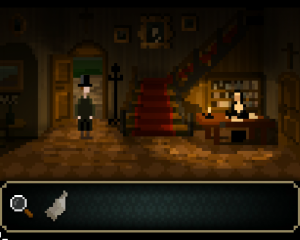 Continuing their haunting tale, The Game Kitchen’s story shows no sign of taking a jolly turn. The same intentionally pixelated graphics of the previous chapter are again in evidence here, the use of shading continuing to be put to good effect. The corridors of the old school are often dark and shadowy, with evidence of decay in many rooms. The characters are once more faceless, the eerie lack of features adding to the horror overtone. There are also a few rooms, mostly seen in the latter half of the game, that present truly disturbing sights. The music is a mixture of subtle, unnerving tunes and more dramatic orchestral pieces. There are also numerous sound effects, such as the panicked breathing in the partly-playable dream sequence at the start.
Continuing their haunting tale, The Game Kitchen’s story shows no sign of taking a jolly turn. The same intentionally pixelated graphics of the previous chapter are again in evidence here, the use of shading continuing to be put to good effect. The corridors of the old school are often dark and shadowy, with evidence of decay in many rooms. The characters are once more faceless, the eerie lack of features adding to the horror overtone. There are also a few rooms, mostly seen in the latter half of the game, that present truly disturbing sights. The music is a mixture of subtle, unnerving tunes and more dramatic orchestral pieces. There are also numerous sound effects, such as the panicked breathing in the partly-playable dream sequence at the start.
This story follows on directly from the previous chapter, and you should play that first. If you have any doubt about what sort of game you are playing, the two opening cutscenes, one with limited interaction, should make it very clear. This is not a game for those with nervous dispositions or for the very young. After the opening scenes, the action feels relatively mundane for a while, but the horror ramps up again before the dramatic ending. Using standard point-and-click controls, you will need to have conversations with the various denizens of the hospital, both to understand the story further and to get clues about their own issues. These side stories are well integrated into the setting, with some even having a direct bearing on your own investigations. You will also make use of a small inventory in creative but ultimately logical ways.
The Last Door: Chapter 2 – Memories (and the previous episode) can be played for free at the developers’ website. Chapter 3 is also available to those making a small donation to further development.
Dopaminium: The Heal Journey
Making a game based on the intricacies of a brain can never be easy, but that’s exactly what shaman4D’s latest game does in Dopaminium: The Heal Journey, a highly bizarre and equally abstract escape-type game which takes you through a journey into the mind. The premise relies heavily on the nature of subconscious thought. Taking into account an array of subject material from psychological textbooks, each level in the game has been crafted to reflect an aspect of the human psyche, including things like depression, mania, anxiety and hallucinations. The introduction alerts you that the experience is supposed be like a dream, so there are no further explanations about what's happening and the game provides very little by way of characters or conventional story, choosing instead to be more about sensations than logic.
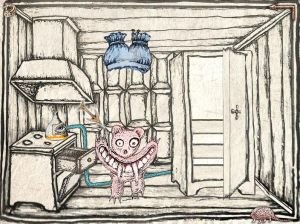 Featuring an esoteric art style, the visuals almost look like something that Terry Gilliam might dream up. The result is highly imaginative but strange, combining sketched backgrounds with a range of detailed objects in a way that throws up all sorts of possibilities. One level is set in the middle of the ocean, featuring a small wooden ship with human eyes and teeth which constantly chomp thin air; another takes place in a museum which turns into a balloon party as soon as you hit the light switch; still another occurs in a narrow corridor with a light bulb powered by a giant flower. Later in this same room, a giant elephant appears. "Surreal" really is the only word you can give to a game like Dopaminium. Music is sparse and only tends to appear during the main menu. Likewise, sound effects are used infrequently, giving the game's abstraction a rather silent and sombre tone.
Featuring an esoteric art style, the visuals almost look like something that Terry Gilliam might dream up. The result is highly imaginative but strange, combining sketched backgrounds with a range of detailed objects in a way that throws up all sorts of possibilities. One level is set in the middle of the ocean, featuring a small wooden ship with human eyes and teeth which constantly chomp thin air; another takes place in a museum which turns into a balloon party as soon as you hit the light switch; still another occurs in a narrow corridor with a light bulb powered by a giant flower. Later in this same room, a giant elephant appears. "Surreal" really is the only word you can give to a game like Dopaminium. Music is sparse and only tends to appear during the main menu. Likewise, sound effects are used infrequently, giving the game's abstraction a rather silent and sombre tone.
The game is made up of individual levels; each area is independent from the others, so Dopaminium is not a linear narrative experience. You can navigate through these using the over-world map, which consists of an image of a brain with separate parts representing a specific mental condition. Inside the stages, the cursor turns blue when you hover over an important object, which can be clicked on or combined with an item from your inventory. You complete each section by finding a hidden coin at the end of each level. This is done by solving puzzles, usually through item combinations or by clicking key objects. Finding the solution to puzzles is a bit of an arbitrary process, but they are not particularly difficult. Actions may be as innocuous as opening drawers, lighting lamps or picking up floorboards. But when doing these results in a giant butterfly fluttering in from the window, an alien flopping from a table or a huge bear appearing, you soon realise that these events are disconnected from reality as well as logic.
Dopaminium: The Heal Journey can be played online at Kongregate.
Monty the Komodo Dragon
Monty the Komodo Dragon is a good father and husband. While his less-than-grateful spouse and offspring lounge back under their shady rock, he heads out into the desert in search of food. A creature of few grunts, he does not begrudge his status as provider. He will feed his family even if it means he has to dodge unwelcome gifts from above and face mighty monsters to bring sustenance home.
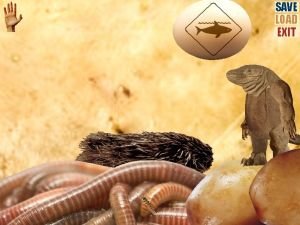 Fitz’s tale of a lizard patriarch is a surreally amusing tale. The graphic style is a photo-mosaic, though Monty’s body has been adjusted so he walks upright instead of on all fours. The elements chosen for the scenery are often bizarre, with the sun being represented by an egg yolk and the sea by a pile of earthworms. Animation is limited to Monty and a few other characters, with fairly simple paper doll animations. Whilst Monty is not voiced as such, he does emit some extremely expressive grunts, and his family makes equally expressive hissing noises of disapproval at many of his food choices. These sounds are supplemented by pictorial speech bubbles to indicate what is being said. The desert also has suitable background noise, such as the far-off cries of birds.
Fitz’s tale of a lizard patriarch is a surreally amusing tale. The graphic style is a photo-mosaic, though Monty’s body has been adjusted so he walks upright instead of on all fours. The elements chosen for the scenery are often bizarre, with the sun being represented by an egg yolk and the sea by a pile of earthworms. Animation is limited to Monty and a few other characters, with fairly simple paper doll animations. Whilst Monty is not voiced as such, he does emit some extremely expressive grunts, and his family makes equally expressive hissing noises of disapproval at many of his food choices. These sounds are supplemented by pictorial speech bubbles to indicate what is being said. The desert also has suitable background noise, such as the far-off cries of birds.
If you find a Komodo dragon walking on two legs odd, this may not be the game for you, as this is just the start of the weirdness. By the end of the game you will have faced off against a giant snake and used a frog in a most unusual fashion. As surreal as the setting is, it should come as no surprise that many of the puzzle solutions are somewhat offbeat as well. However, once the bizarre nature of the situation is accepted, the puzzles become logical in that context. Using a single click for all actions, a limited inventory and a certain amount of physical violence towards trees will see you through. Light humour is the emotional order of the day, with the pictures used for family conversations proving a particular source of laughs for me.
Monty the Komodo Dragon can be downloaded from the AGS website.
Raven Crime
Anna Gomez is dead. She has fallen prey to the ruthlessness of an unknown killer and it is up to John Anderson to find the culprit. This is New York, the city that never sleeps, and this is Raven Crime, Jacob Dzwinel’s point-and-click ode to neo-noir classics such as Se7en and Sin City. Upon discovering Anna’s body, John notices a tattoo of a black raven on her shoulder. It is up to the police detective to figure out the link between this image and Anna’s death. Using detective skills to uncover the clues, you'll be led through an intricate web of mystery as the shadow of the callous killer looms large.
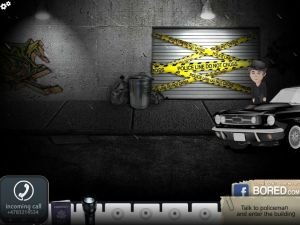 Raven Crime opts for a neo-noir look. Each area is usually filled with detail, using images of desolate street corners and abandoned office complexes to instil a level of grittiness. While the backgrounds invoke a filmic quality, the characters are more cartoonish-looking. Such juxtaposition seems like a strange choice, but whereas the art style is a little bit inconsistent, the overall production is generally very good. Dialogue trees frequently pop up to expand on the story and these often give more background about the characters you encounter. This includes conversations with criminals, homeless people, drug-dealers and streets thugs, all conducted in search of more information about the mysterious serial killer. Navigation is seamless and moving John about requires nothing more than a simple click of the mouse. In fact, most interaction is performed exclusively using the left-click button.
Raven Crime opts for a neo-noir look. Each area is usually filled with detail, using images of desolate street corners and abandoned office complexes to instil a level of grittiness. While the backgrounds invoke a filmic quality, the characters are more cartoonish-looking. Such juxtaposition seems like a strange choice, but whereas the art style is a little bit inconsistent, the overall production is generally very good. Dialogue trees frequently pop up to expand on the story and these often give more background about the characters you encounter. This includes conversations with criminals, homeless people, drug-dealers and streets thugs, all conducted in search of more information about the mysterious serial killer. Navigation is seamless and moving John about requires nothing more than a simple click of the mouse. In fact, most interaction is performed exclusively using the left-click button.
Solving puzzles is also generally done this way but sometimes incorporates the keyboard as well. These puzzles consist of anything from finding important objects to unscrambling newspaper cuttings, taking photographs and picking locks. After examining the dead body at the start of the game, John finds himself stuck inside the office complex seeking escape. With no phone signal, he is unable to call for help and you must scurry through the deserted building looking for a way out. By scouring through drawers, couches, trash bags and lockers, you'll pick up a range of important objects. These go into your inventory, alongside a note informing you of your next goal and a telephone which is used for frequent contact with your assistant. This case reaches a proper conclusion, but don't be surprised if this isn't the last of John Anderson’s case that we’re given to solve.
Raven Crime can be played online at Kongregate.
Vortex Point 3: Lake Monsters
In the town of Vortex Point, the supernatural is so commonplace as to be almost natural. Now the local paranormal investigators have a new case. A guest at the local lakeside hotel has vanished without a trace. Could it be that the fabled monster said to reside in the depths of the lake has risen up and consumed him? As the on-site investigator Kevin settles in for the night, he might find that there is more to this case than meets the eye.
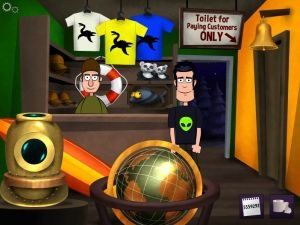 Esthetix takes on another trip to this small town of the strange. The graphics use the same bright and smoothly animated style of the previous instalments. This time the action takes place at night, with many darker scenes, such as the lakeside dock. With this cartoony visual style, however, even relative darkness does not make items hard to see. The game is fully voiced to a passable standard, with characters such as the creepy hotel owner having their own distinct personalities. Background music is a piece somewhat akin to whale song, fitting the aquatic theme of the monster at the heart of this tale.
Esthetix takes on another trip to this small town of the strange. The graphics use the same bright and smoothly animated style of the previous instalments. This time the action takes place at night, with many darker scenes, such as the lakeside dock. With this cartoony visual style, however, even relative darkness does not make items hard to see. The game is fully voiced to a passable standard, with characters such as the creepy hotel owner having their own distinct personalities. Background music is a piece somewhat akin to whale song, fitting the aquatic theme of the monster at the heart of this tale.
Once more inventory plays a significant role in your adventure, with items ranging from hotel room keys to rolls of toilet paper playing their part. You will also make use of the telephone and interact with both the hotel owner and the equally disturbing proprietor of the local souvenir shop. Plus there is a puzzle in which you need to decipher three different clues in order to program the hotel’s automated tour boat. Single-click controls make walking about and interacting easy, simply highlighting inventory items for use. The story is entirely self-contained, with no need to have played either of the previous two episodes to understand what is going on.
Vortex Point 3: Lake Monsters can be played online at Mouse City.
Other new releases
Not all games are created equal, and freeware games especially come in all shapes and sizes. Not to be overlooked, the following list might also be of interest, though these games may be significantly shorter or less polished, more experimental titles than those detailed above, some perhaps only borderline adventures to begin with.
Robot Psychiatrist by Scott Winnicott – You’ve undertaken years of study, and now only a few last tests stand between you and a new robopsychiatry career.
Back in Time by Carmel Games – A time machine accident puts a scientist back in the Middle Ages without the power he needs to get home again.
Uncle Vince's Mission In-VINCE-able by ClickShake Games – Agent Vince must infiltrate a mob boss headquarters in an innuendo-filled adventure unsuitable for the young.
That’s it for this month. Think we’ve missed a gem or want to tell us about your own game? Then pop in to our Adventure forum and tell us about it!
Stephen Brown, Mitchell North, and Willem Tjerkstra contributed to this article.




